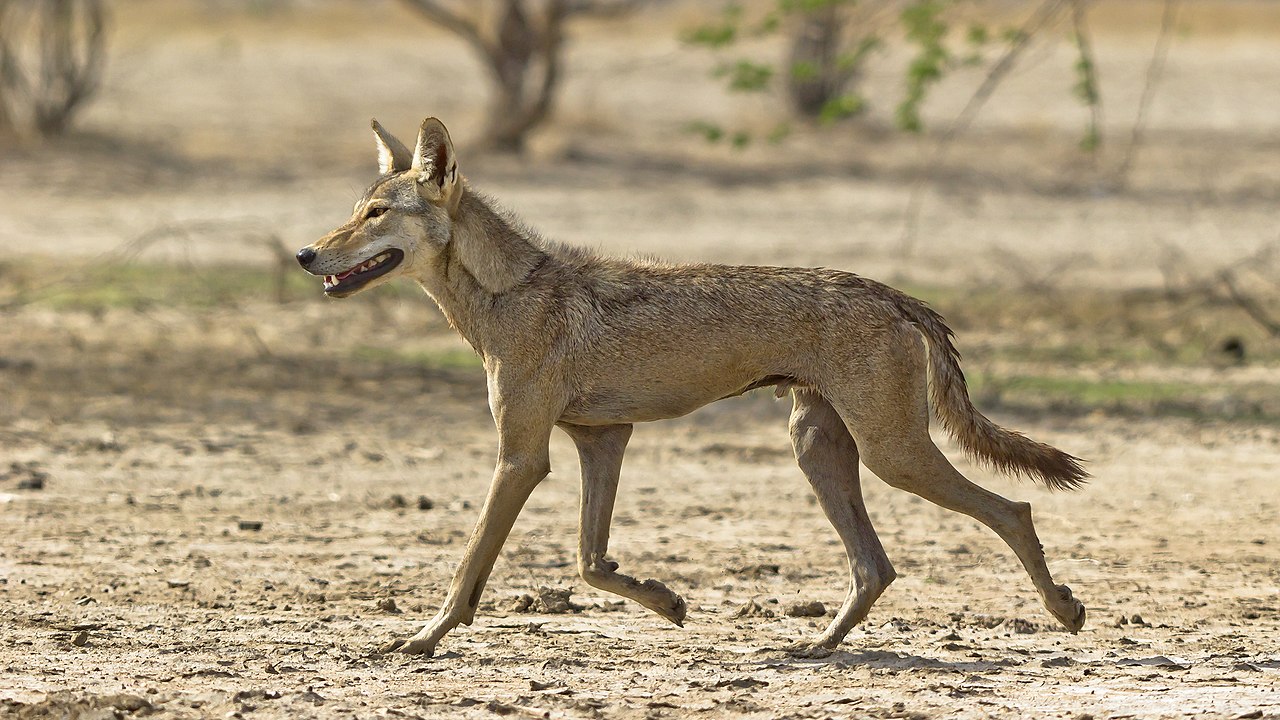
An Indian wolf at the Blackbuck National Park, Gujarat, June 2017. Photo: Dhaval Vargiya/Wikimedia Commons, CC BY-SA 4.0
- The authors recently reviewed the scientific literature on carnivores in post-independent India and found that one species has dominated our attention: the tiger.
- Its charisma has led to the establishment of ‘Project Tiger’ and more than 50 tiger reserves across India; and its presence has been used to bolster the protection of prime forest habitats.
- But the tiger’s other, less-charismatic counterparts haven’t been as empowered through conservation policymaking and research or conservation focus.
India just surpassed the UK to become the fifth largest economy in the world, in the same year the country is celebrating its 75th year of independence from British rule.
At this key juncture, we must also not lose sight of the challenges ahead of us, especially the climate crisis and the ongoing sixth mass extinction kickstarted by our way of life. It is time for India to radically pivot its policies around the principle of ecological sustenance and secure a viable future for its people. By doing so, the country can set a powerful example as an emerging global leader.
The fact that India is home to almost a quarter of the world’s carnivores will bolster such initiatives. After all, few other wild animals inspire the general public to care for the natural world as carnivores do with their charisma, prowess and appeal. Carnivores could arguably be the strongest sentinels for biodiversity conservation.
As apex predators, their conservation has the ability to preserve the food webs of entire ecosystems. But not all of our native carnivores are getting the support they deserve. The numerous ecosystems and ecological communities they represent are not safeguarded from destruction. The Indian-government-led tiger research and conservation efforts, for example, alone receive Rs 220 crore a year, while most other carnivores don’t receive nearly the same kind of attention or resources.
Social scientists have often asked whether existing development policies benefit marginalised sections of society. Likewise, it is time we ask whether all carnivores get the attention they deserve. We and our peers recently reviewed the scientific literature on carnivores in post-independent India and found that one species has dominated our attention: the tiger. Its charisma has led to the establishment of ‘Project Tiger’ and more than 50 tiger reserves across India; and its presence has been used to strengthen litigation measures against the destruction and fragmentation of prime forest habitats. But the tiger’s other, less-charismatic counterparts haven’t been as empowered through conservation policymaking.
Many of India’s unique and fascinating carnivore species remain on the sidelines, with little research or conservation focus. For example, the caracal (Caracal caracal), an elusive medium-sized cat, occupies just 5% of its former range in the country. Once used as extensively as the cheetah to hunt free-ranging game species, the caracal is fading into oblivion even as we discover the species’ basic ecological requirements.
To make matters worse, the Indian government has characterised the caracal’s grassland and open savanna habitat as ‘wastelands’ in its land-use policies. So they are frequently diverted for commercial use, including for the construction of large-scale “green” solar energy farms. Other sympatric carnivores like the desert fox, desert cat, striped hyena and Indian wolf can also benefit if these landscapes are recognised as unique ecosystems worthy of conservation.
Our blinkered vision that only views ‘forested areas’ as biodiversity hubs is a key point of concern. For example, India is supposed to safeguard its wetland ecosystems from destruction and degradation under the Wetlands (Conservation and Management) Rules 2017. However, according to the country’s land-use policies, certain types of wetlands are also designated ‘wastelands’.
A law should supersede a policy – but wetlands across India are being rapidly degraded because most of them are not a part of state wetland inventories, a mandate set forth by the Supreme Court. Wetland-sensitive species like fishing cats and otters bear the brunt of this policy contradiction within the country’s legal infrastructure. As a result, we are losing our wetlands – which are natural inland fisheries, water reservoirs and carbon sinks.
We actually know very little about the status of many carnivore species in India and less still about their functional roles. Studies have shown how otters maintain aquatic forests and natural fish populations by keeping aquatic herbivores in check. Wolves maintain forest ecosystems by regulating herbivore populations. India has an incredible diversity of carnivores, yet it lacks research on these aspects. This is particularly jarring, since 2022 also marks 50 years since the promulgation of the Wildlife (Protection) Act.
Several hurdles impede the broadening of carnivore research in India, many of which can be amended through proactive government facilitation. For example, funds for wildlife research are mostly channelled towards national parks and tiger reserves. Crossing bureaucratic hurdles and procedural delays to obtain research permits to work inside such protected areas often discourages independent research.
Moreover, philanthropies in India and corporate institutions (through CSR programmes) should consider scaling up their contributions to carnivore research and conservation. Most of our carnivores also exist outside protected areas and share space with people. India needs to encourage collaborative, constructive, inter-disciplinary and socio-ecologically sensitive scientific endeavours and conservation approaches in such landscapes.
Expanding the frontiers of carnivore research could potentially set the precedent to broaden biodiversity and conservation research in India. By doing so, the country should aspire to match global gold standards in conservation research, alongside the strides we are making in terms of our economic power.
Soumya Banerjee is project associate, Wildlife Institute of India, Dehradun. Arjun Srivathsa is with the Wildlife Conservation Society-India, Bengaluru and the National Centre for Biological Sciences, Bengaluru, and DST Inspire Fellow, affiliate scientist, WCS India.

